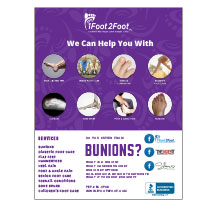Table of Contents
Bunions - Introduction
A bunion is a bony growth that occurs at the joint of the big toe. Bunions can be painful and aesthetically unpleasant. Bunions develop slowly as the bones of the foot shift over time as the big toe moves towards the second toe. The bump will gradually increase and can cause pain when walking or wearing shoes. A bunion can severely alter the appearance of the foot, and the toes rubbing together can form thick callouses that cause more discomfort in the foot. Luckily there are treatments, both surgical and non-surgical, available to relieve pain and return the foot to normal alignment.
What are the Symptoms of Bunions?
Bunions cause a visible bony bump at the joint of the big toe. There may be redness, swelling, or discomfort of the big toe joint. Bunions can cause foot pain, and the pain may be chronic or intermittent depending on the severity of the bunion. Over time, you may notice a decrease in the flexibility of the foot as the muscles stretch in the wrong direction. Calluses or corns may also develop where the toes overlap and rub together.
What Causes Bunions?
Bunions are thought to have a genetic component. Other causes are flat feet, abnormal structure of the foot, and foot injuries. Footwear can also be a contributing factor, as wearing too-tight or pointy-toed shoes compress the toes and increase the risk of developing bunions. Some individuals with autoimmune diseases, such as rheumatoid arthritis, are more likely to develop bunions as part of their disease progression. As the bunion continues to progress, it may lead to other foot-related conditions such as hammertoe, an abnormal bend in the middle joint of the toe, and bursitis, inflammation of the fluid-filled pads that cushion bones and tendons. Both are painful conditions that may require additional treatment.
Should I Worry About My Bunion?
What Can I do at Home to Help with Bunion Pain?
If your medical professional has given you the green light to do treatment at home, there are several things you can do to ease the pain that minor bunions can cause. The first is to make a change in your footwear. Your podiatrist can measure your feet and help you choose orthotics that will help alleviate your foot pain and realign the foot correctly. Make sure your feet are measured each time you purchase a new pair of shoes. Eliminate pointy-toed shoes and ensure that the toe-box of your shoes is wide enough for your feet.
You can also purchase over the counter “bunion pads” that can cushion the bony bump from the shoe. Be sure that you test the pads out for a short time before wearing them for a full day to make sure that the pad doesn’t increase the pressure on the bump, as this can cause additional pain.
You can also try cold therapy. You can use an ice pack on the affected toe for 20 minutes at a time, taking care to ensure that the ice pack does not come into direct contact with the skin. This can decrease inflammation to the painful joint.
Medications can also help to alleviate swelling and pain associated with bunions. Over the counter nonsteroidal anti-inflammatories such as ibuprofen and naproxen may be recommended by your doctor. Be sure to adhere to the medication guidelines and check with your doctor to make sure your existing medications will not interact with the NSAIDs recommended.
What if My Doctor Recommends Surgery?
In some cases, your doctor may recommend surgery to correct the damage done to the foot alignment and relieve pain. If this is the case, your podiatrist will present you with several options for surgical correction and outline the best course of treatment and aftercare. In some patients, the procedure is done outpatient, and you may be able to bear weight on the affected foot in around three days with a protective boot or recommended footwear. Be sure to follow all aftercare instructions and attend all follow-up appointments to ensure the bunion does not reoccur.
Conclusion
Don’t wait until your bunion is so severe that surgical intervention is your only option. The team at 1Foot 2Foot can do an evaluation of your bunion and determine a treatment plan that is specific to your needs. Our award-winning podiatrists are ready to get you started living pain-free today.


